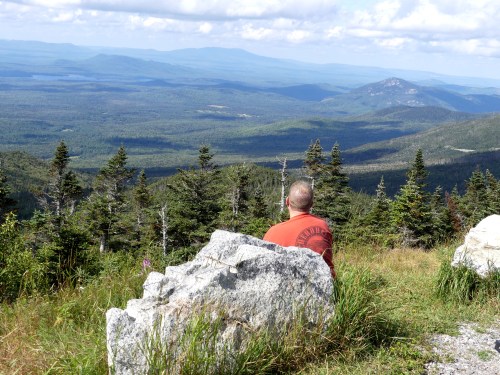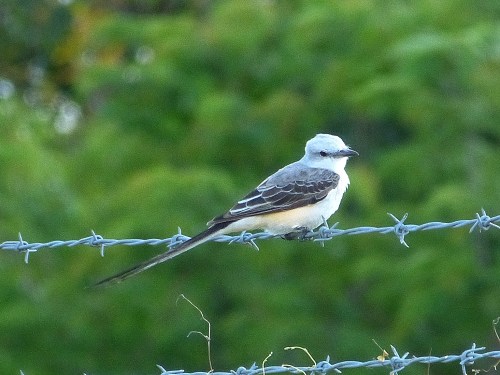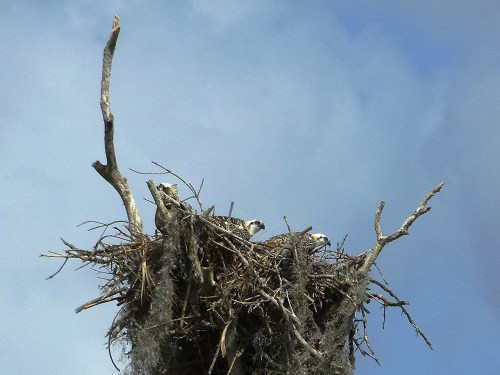David has dreamed of riding his bicycle to Key West for several years. He explored several organized rides, but none of them felt right to him, so he asked me if I would SAG for him if he did a solo trip. David is one of my best friends, so, of course, I said yes. Plus, I might even get a life bird if I was lucky. I hadn’t had a life bird in Florida since 2015, but typically a few rarities show up every winter in the southern part of the state, so I was hopeful. In cycling terms, SAG means support and gear; I would drive David’s car along his bike route carrying food, water, tools and parts for minor bike repairs, extra clothing, etc. We decided to start the cycling adventure in Naples Beach, travel east across US 41, and then drive/cycle down US 1 through the Keys. To save money and give us a little flexibility, we would spend five nights in Florida City.
When I left home on February 10, there were three possible life birds that I could get, plus anything new that might show up. I got a late start and spent the first night in southern Georgia. The next morning, I headed towards Merritt Island NWR where a Great White Pelican had been regularly seen for a couple of weeks, including the previous day. After I got on the road, I learned that Black Point Wildlife Drive, the spot where the pelican was most often seen, was closed for a controlled burn. I arrived around noon and checked a few other locations where it was speculated that the bird could have gone. I found a group of American White Pelicans at Haulover Creek, but not my target bird.
At the Merritt Island NWR Visitor Center that afternoon, I was consoled by several beautiful Painted Buntings. It’s hard to be sad while watching these gorgeous birds. Below, the colorful male is on the left and the pretty yellow-green female on the right.
After the Visitor Center closed, I was looking at birds in the trees in the parking lot when I heard what I thought was a woodpecker, but I couldn’t find it. Finally, I discovered the source of the pecking sound – a male Northern Cardinal challenging his own reflection in the rear view window of my car! This behavior isn’t unusual, but I rarely see it.
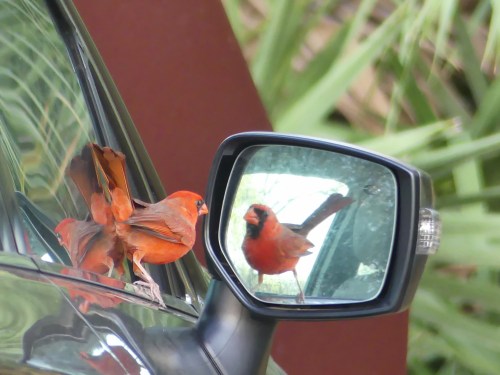
The next morning, I went back to the Visitor Center to find out when the wildlife drive would open. “Noon,” they said, too late for me as I wanted to head to Dunedin to stay with David and Val that evening. Again, I birded in the parts of the refuge that were open and actually enjoyed it more than the previous day. I had given up on the pelican and just enjoyed what I did see.
Birds winter in this area in large numbers and I saw 50 species with my modest efforts on two short days – herons, egrets, ibises, shorebirds, ducks, and more. My favorite animal wasn’t a bird, though, but this adorable Hispid Cotton Rat under the Merritt Island NWR Visitor Center feeders. I was disappointed that I hadn’t found the pelican, but genuinely happy to see the rat, a life mammal.
I grew up in Pinellas County and I’ve visited so often the last few years that it feels like home. My favorite birding locations are Dunedin Causeway and Honeymoon Island State Park, so that’s where I headed on Thursday after arriving the previous afternoon. I had a great time at Honeymoon Island, but I couldn’t concentrate on birding because people were so friendly! Everyone wanted to talk, but I enjoyed the conversations, especially with a young couple who thanked me for being their “tour guide” after we watched a Gopher Tortoise together. It was a special treat to see this creature, a threatened species in Florida. Gopher Tortoises are important because they dig burrows deep in the sand that are used by over 350 other species including Burrowing Owl. Many of those species could not survive without the Gopher Tortoise. This particular tortoise is one of the largest that I’ve seen; note it’s smooth shell from years of burrowing in the sand.
In late winter, it’s always thrilling to observe the many Osprey at the height of courtship. Everywhere you look, Osprey are fishing, eating, calling, sitting near their mates (or intended), and soaring overhead. This male Osprey is enjoying lunch. Who can identify the fish by its distinctively shaped red tail? Please leave a comment if you know what it is.

I had one more day to go birding before David and I headed south, so I went to Dunedin Hammock City Park to look for the Short-tailed Hawks that had been reported there. I ran into a local birder who told me that the hawks had nested in the park since 2017. We went our separate ways and then ran into each other twice more. Just before we both needed to leave, he caught a glimpse through the trees of a hawk flying. We waited and it soared overhead for a minute, confirming its identify and allowing me to get a bad photo, but good enough for the local eBird reviewer to confirm my report.
This Snowy Egret at Dunedin Hammock was lovely in breeding plumage and much more cooperative than the Short-tailed Hawk.
I had enough time left that afternoon to find a Purple Gallinule (rare for Pinellas County) and then it was time to meet David after work and get ready for his big cycling adventure.
All we had to do on Saturday was drive to Naples to be in place for David’s start on Sunday morning, so we were able to do a little birding on our way down the Gulf Coast. Our first stop was at a place near Sarasota called “Celery Fields” by Florida birders. We had no idea what to expect and were surprised by the wonderful feeder area where we spent most of our time. We had great close looks at Common Ground Doves, a species that we have seen often, but never so well. A Brown-headed Cowbird is in the shadows behind the dove in the photo below.

Most fun, though, were the Nanday Parakeets, who swooped down into the feeder area and took all our attention. This is another species that we had seen before, but not this close. We found it interesting that the middle bird below was hanging by one foot with its head in the feeder port.

Below, a single Nanday Parakeet poses for a portrait photo.
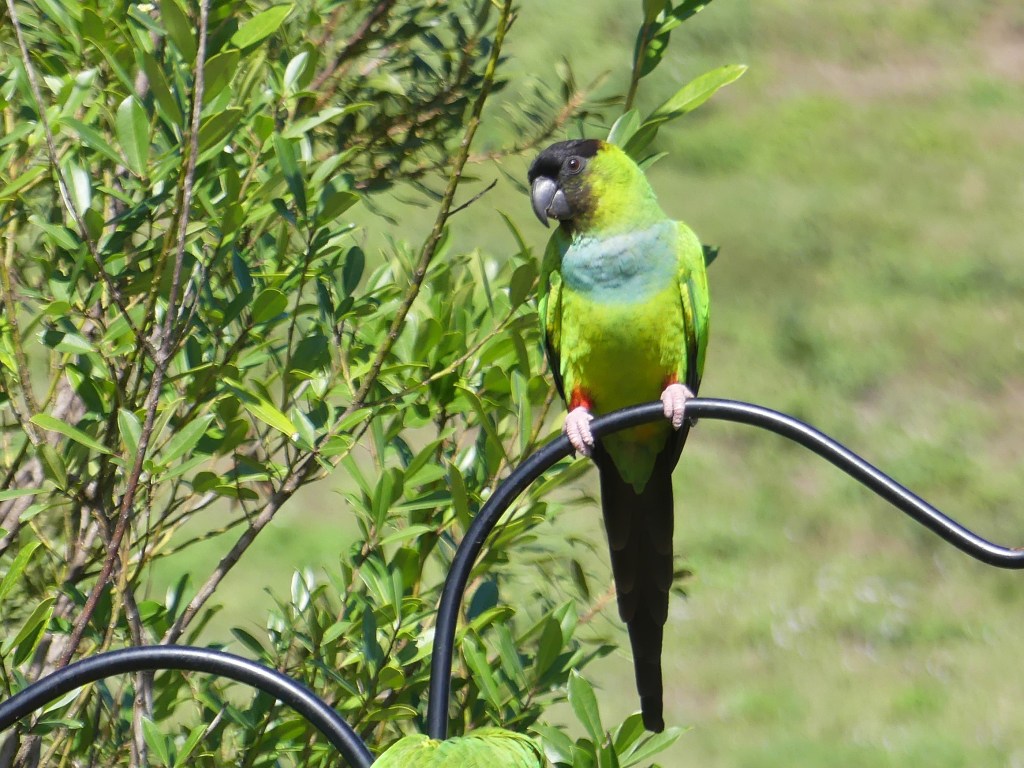
We made another stop at Corkscrew Swamp, a favorite place of mine since I lived in Miami in the early 1980’s. Wood Storks were much less common then (they were assigned endangered status from 1984 to 2014). To see these birds, we had to drive across the state to Corkscrew which was the breeding ground for about half of the Southern Florida population then. Fortunately, they have had a good recovery and are now easy to see in many areas of Florida.
I had planned to look for the White-cheeked Pintail in Naples, which had been seen for weeks before I left North Carolina. But, by the time we got there, the duck had been missing for eight days, so we didn’t spend time looking. Yep, another lost opportunity for a life bird.
David started his ride from Naples Beach on Sunday morning. Our first two days across US 41 were rather tedious and I didn’t see many birds. But, I did enjoy birding the Shark Valley entrance road for an hour on Monday morning where I saw this Anhinga in the ditch drying its wings.

The trip would soon got more interesting for both of us. Watch for part 2. Read David’s story about this part of the trip in his blog post, Bicycling Naples to Key West – Part 1.









